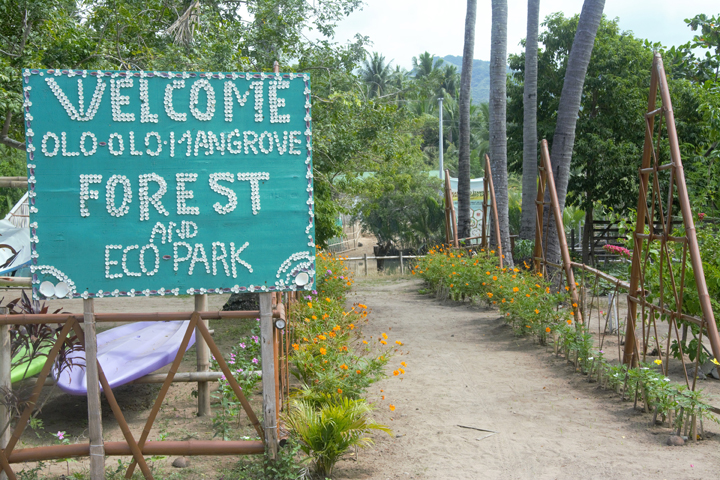BY this time of the year, a hundred trees in this coastal community would have been cut down, repainted, decorated and sold as Christmas trees to give joy to homes in downtown Lobo, a small town in Batangas province.
The mangrove tree species, locally called palapat, is popular among children in this coastal barangay called Olo-olo because they make beautiful Christmas trees, the demand for which rises during the so-called “ber” months leading up to Christmas.

“By October and November, children here would have been busy cutting palapat to make Christmas trees. It’s a project every year for young children here,” said Ronnie P. Gamboa, chairman of the Olo-olo Seaside Worker Association (Oswa).
Palapat is also commonly used as construction material. Its trunk and branches make a good wooden post and kilo or beam of a nipa hut, Gamboa said in Filipino.
Another mangrove species, pipisik to local folks, is used as kumpay, the wood carved to fit the back of a carabao to pull a wooden cart behind it.
The pipisik is harvested by local folks for various purposes. The leaves are fed to carabaos, cows and small ruminants. The trunk and branch are used to make charcoal, a common livelihood in the barangay.
Food source
GAMBOA told the BusinessMirror in a recent interview that they used to believe the mangrove forest in their area is so thick that cutting and harvesting pipisik and palapat would last forever and would never affect their food source.
However, owing to cutting for a long time, the thick mangrove forest eventually shrunk and the native fish species, mud crabs and seashells became scarce until, finally, the Department of Environment and Natural Resources (DENR) stepped into the picture.
“When the DENR came and told us to stop [cutting trees], we all stopped. Since then, there was no more cutting, even for Christmas,” he said.

He said the people in the small community are currently slowly feeling the positive impact of maintaining a healthy environment.
Their 21-hectare patch of green fronting the Verde Island Passage that surrounds an estuary is again teeming with assorted species of native fish, mud crab and shellfish.
“You’ll never go hungry with this abundance,” he said, referring to the mangrove forest. “See those holes in the sand? There are mud crabs inside those holes,” Gamboa boasts.
Batangas ICM
BATANGAS has been implementing integrated coastal management (ICM) as early as the mid-1990s.
In 2004, as a demonstration site of the Partnerships in Environmental Management for the Seas of East Asia (Pemsea), the implementation of various ICM projects intensified.
The demonstration project in Batangas resulted in the development and implementation of a Strategic Environmental Management Plan consisting of six major action areas: legal and institutional mechanisms, integrated policy and planning systems, integrated management systems and technical interventions, management and technical skills improvement, information base improvement and sustainable financing development.
Technical, institutional and financial support has been provided through a regular allocation from the provincial budget since 1999.
ICM was implemented first in Batangas Bay. Inspired by the positive impact of the ICM, it was replicated by the provincial government in Balayan Bay and adjacent bays of the province.
The ICM program has been scaled up recently to cover the entire coastline of the province.
The ICM strategies in Batangas includes food security and livelihood through biodiversity-friendly enterprises, gear selectivity to avoid overfishing and destructive fishing, and information, education and communications to achieve the United Nations Sustainable Development Goals, particularly SDG 11 or Sustainable Communities; and habitat protection, particularly ecosystems like mangroves, seagrass, coral reefs, marine protected area (MPA) monitoring and establishment linked to SDG 14, or Life Below Water.
Environmental defenders
OSWA, which has evolved as protector of the mangrove forest in the barangay to defenders of the environment, is now into managing a promising tourist magnet in Lobo called Olo-olo Mangrove Forest and Ecopark.
Speaking in Filipino, officers of Oswa narrated how the group started and became a model organization practicing biodiversity-friendly business enterprise in Lobo.
In 2009 the DENR urged residents of Barangay Olo-olo to stop harvesting mangroves to prevent further environmental damage in the coastal communities in Batangas.
“Somebody from the DENR helped organize our group. They facilitated a training for us and provided capital for our livelihood. We were given two kayaks and two paddleboards, a bamboo raft and an initial capital of P40,000,” said Lolita Manalo, the group’s secretary.
Their job then was to protect the mangrove forest and the estuary against various threats, particularly harvesting of mangrove trees, illegal fishing and use of destructive fishing methods, and hunting wildlife, including native birds that thrive in the area.
Rich biodiversity
BARANGAY Olo-olo’s mangrove forest is rich in biodiversity Besides samaral, kitang and banakfishes, and shrimp, which provide the communities with adequate food on top of the mud crabs and other shellfish that are abundant in the area, the mangrove forest is known to host a good number of native birds that are unique to the town of Lobo.
“We have the iliw here,” Manalo said. Iliw is described as bee-eater.
“They come here in the afternoon, around 5:30 p.m.. They fly atop and they perk on tree branches,” said Amanda Duena, another official of Oswa. The multicolored-feathered flyers have green, blue, red colors that distinguished three from other birds.
The area is also frequented by migratory birds during migration season.
Biodiversity-friendly enterprise
WHEN the group started in 2009, they ventured in various livelihood activities, starting with raising milkfish and tilapia, culturing mud crabs and harvesting shellfish near a small lagoon called puktol.
The river-like lagoon called pailog, a contraction of the words papunta(going to) and ilog (river) stretches up to about 1.6 kilometers within the park.
They said they try to minimize or limit activities to avoid environmental degradation, such as operating small fish cages within the carrying capacity of the river-estuary, sustainable harvesting of fish, mud crabs, seashells and other food from the mangrove forest.
To sustain their livelihood, the group ventures in tourism-related services like renting a kayak, paddle boards, bamboo rafts, floating huts and boating to tourists who want to go bathing, swimming or simply enjoy the green space in their small town.
Ecotourism
MANALO said in February 2017, two months before former Environment Secretary Regina Paz L. Lopez had to step down, Lopez visited Barangay Olo-olo and suggested they expand their small business.
Now, their biodiversity-friendly enterprises include a package of ecotourism services which they continue to enhance, making use of indigenous materials whenever possible.
The group’s eco-trail in the mangrove forest is made of wood and bamboo poles. Their bamboo raft and fish cages use materials that are abundant and found naturally in their area, an idea brought up by Lopez herself.
Lopez promised the group financial support for a package of services to boost their livelihood activities. Unfortunately, her stint as DENR secretary was short-lived after being rejected by the Commission on Appointments in April last year.
Nevertheless, the group continued to run the place which offers peace and tranquility, unlimited fun and adventure where nature can be enjoyed in its pristine state.
The group offers water sports, recreational fishing, rafting, kayaking, stand-up paddle boarding, snorkeling and scuba diving.
As a treat to its visitors, the group also offers a unique experience by enjoying the abundance of nature through shell and crab harvesting, bird and firefly watching, mangrove planting, fish feeding, eco-walk within the mangrove forest, and of course, bathing and swimming.
On its own, members of Oswa remain hopeful to sustain their biodiversity-friendly business enterprises by managing a potential tourist magnet in their small green space in the town called Lobo.
Published in Business Mirror.

